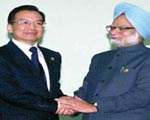
June 07: The first ever joint army exercise between India and China and with it a new chapter in the joint relations will be initiated between the countries, which were engaged in one of the deadliest wars in 1962.
A total of 100 Indian troops will participate in joint army exercise in China, in October this year. Participants will work out anti-terrorism tactics, besides other related aspects and operations.
The decision was taken during Indian army chief, General J.J.Singh, recent visit to the communist nation, at the end of May. Giving credit to the General’s visit, Defence Ministry claimed a decision on “engagement and mutual confidence building” including joint training exercises.
The exercise is one of the widely expected initiatives to be undertaken by the respective governments. The two countries are eager to take forward the bi lateral relations, initiated by mutual economic agreements.
"We had a small thing earlier -- not an exercise but a mountaineering expedition, two years ago," army spokesman, Colonel S.K.Sakhuja was quoted by news agencies.
The agreement comes after the army chief visited China at the end of May, which the Defence Ministry said had led to a decision on ‘engagement and mutual confidence building’ including more joint training exercises.
Historic rivals conducted joint naval exercises in the East China Sea in 2003, but otherwise contacts between two of the world's largest armed forces have been scant.
The joint exercise might be a good sign of the developing bilateral relations but the dispute over the territories is still there. India says China occupies 38,000 square kilometres (14,670 square miles) of its territory in Ladakh region of Jammu and Kashmir state. The same is being claimed by Pakistan because of the joint claims over the state of Jammu and Kashmir. Meanwhile, Beijing claims 90,000 square kilometres, or the whole of the northeastern Indian state of Arunachal Pradesh.
Diplomatic contacts between the two economic rivals have increased in recent years, with many bilateral visits and two-way trade touching two billion dollars a month.
Economic relations began to improve in the 1980s. Indian Prime Minister Rajiv Gandhi in 1988, President K. R. Narayanan in May 2000 and Prime Minister Atal Behari Vajpayee in June 2003 visited the People's Republic of China, while former Premier Li Peng and Premier Zhu Rongji came to India in June 2001 and January 2002 respectively. These visits gave a boost to diplomatic and trade relations.
Bilateral trade, which amounted to US$3 billion per year five years ago, has now grown to more than US$10 billion. The opening of a trade route over the Nathula Pass which links India and Tibet, has proved to be beneficial in easing the tension, at least, in the adjoin areas.
Joint Military exercises along with growing economic relations seem to have paved the way, now, to go for overwhelming hug. It should follow with ‘negotiations’ not just ‘empty talks’, as has been the status quo on both sides.
|
|
Read More: Ladakh | East Godavari


Comments:
pawan
June 21, 2007 at 12:00 AM
Economic relations began to improve in the 1980s. Indian Prime Minister Rajiv Gandhi in 1988, President K. R. Narayanan in May 2000 and Prime Minister Atal Behari Vajpayee in June 2003 visited the People's Republic of China, while former Premier Li Peng and Premier Zhu Rongji came to India in June 2001 and January 2002 respectively. These visits gave a boost to diplomatic and trade relations.
Bilateral trade, which amounted to US$3 billion per year five years ago, has now grown to more than US$10 billion. The opening of a trade route over the Nathula Pass which links India and Tibet, has proved to be beneficial in easing the tension, at least, in the adjoin areas.